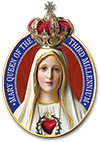
Far from being arbitrary impositions, “dogmas are lights along the path of faith; they illuminate it and make it secure.” Catechism of the Catholic Church #88
Our Lord Jesus, desired to institute a living Magisterium, confided to the Pope and the bishops, successors of the Apostles. They are not only teachers but also shepherds; their teachings aim at intervening in the concrete order of facts. It is the love of the faithful people who, inspired by the Holy Spirit, urge their Shepherds to explain certain points of Revelation. Thus, the new dogmatic definitions are not born from cold doctrinal reflections, but from the legitimate needs and desires of the people of God.
The proclamations of Marian dogmas have been beautiful testimonies of this intertwining of the living Magisterium and the fervor of the faithful since the first centuries of Christianity. The emergence of the first heresies and the impulse of love for the truth which rose up against them gave the singular opportunity for the development of Christian Doctrine, fostering theological reflection and aiding the interventions of the Magisterium of the Church, vigilant defender of the Faith.
Our Holy Catholic Church has declared the following as the main Marian Dogmas: Divine Maternity, Perpetual Virginity, Dogma of the Immaculate Conception, and her Assumption into Heaven.
Divine Maternity
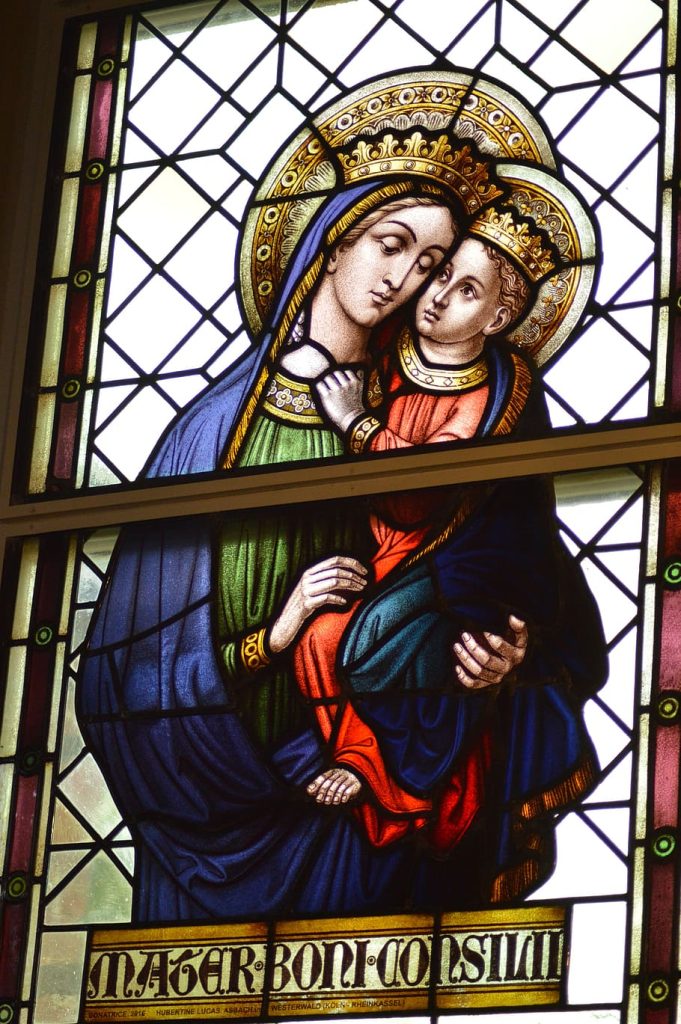
Among the countless lessons that history has given men, there is one of capital importance: the most effective way of combating a truth is not always in spreading the error opposed to it, but in exaggerating some of its aspects. This is confirmed in examining the pendular movement of the heresies of the first centuries, which, under the guise of zeal and the pious defense of orthodoxy, reached heterodox extremes, equally removed from the balance of the Faith. This took place, for example, with the heresy that led to the definition of the first Marian dogma.
A pernicious Christological error filtered among the faithful in the fourth century, disseminated by Apollinaris, anti-Arian Bishop of Laodicea, who, alleging the need to safeguard the unity of Christ with God, ended up by cutting Him off from human nature, denying the existence of the human soul in the Word Incarnate.
Against the Apollinarists—as the followers of the heresiarch came to be known—Nestorius, Patriarch of Constantinople, came to the fore, defending the integrity of both the human and divine nature, but affirming an opposite error: both natures were so complete that they formed two independent hypostases, two persons united in an extrinsic and accidental manner. Thus, Christ would be God and man, not in the Catholic sense of the hypostatic union of the Word with humanity, but forming a composite of two distinct persons, having only a moral union. This doctrine implied an important corollary: Mary was not the Mother of the divine person, but only of the human nature of Christ. Therefore, she should be called Khristotókos (Mother of Christ), and not Theotókos (Mother of God).
This affirmation was an affront against both the teachings of the Fathers, as well as the piety of the faithful, who were greatly incensed with the propositions of Nestorius.
Indeed, clear doctrinal precedents established by dogma appear from the earliest ages of Christian literature. Even in the writings of St. Ignatius of Antioch—a disciple of the Apostle John—we find expressions such as these: “For our God, Jesus Christ, was, according to the appointment of God, conceived in the womb by Mary, of the seed of David, but by the Holy Ghost” (ST. IGNATIUS OF ANTIOCH. Epistle to the Ephesians, 18,2.); “For I have observed that you are perfected in an immoveable faith. […] … being fully persuaded with respect to our Lord, that He was truly of the seed of David according to the flesh, and the Son of God according to the will and power of God; that He was truly born of a virgin…” (ST. IGNATIUS OF ANTIOCH. Epistle to the Smyrnaeans, 1,1.)
In the second century, St. Irenaeus analogously stated this in attributing eternal and temporal generation to the same Person, emphasizing the personal unity of Christ, Word of God and Son of Mary: “He therefore, the Son of God, our Lord, being the Word of the Father, and the Son of man, since He had a generation as to His human nature from Mary—who was descended from mankind, and who was herself a human being—was made the Son of man.” (ST. IRENEAUS OF LYON. Against Heresies, l.3, c.19, 3.)
The devotion of the faithful to “Sancta Dei Genitrix (Holy Mother of God)” is seen at least from the third century, in the prayer Sub tuum præsidium, the most ancient prayer known to invoke Mary in this manner. (ROSCHINI, Gabriel. Instruções marianas. São Paulo: Paulinas, 1960, p.44.) As Gabriel Roschini affirms, “in the fourth century, even before the Council of Ephesus, the expression Mother of God had become so common among the faithful that it enraged the Emperor Julian the Apostate.” (ROSCHINI, Gabriel. idem)
There are breathtaking pages in this chapter in the history of the Church in which, headed by the great St. Cyril of Alexandria, in the year 431, the Council of Ephesus defined the truth destined to shine forever in the firmament of theology: “If anyone does not confess that Emmanuel is God in truth, and therefore that the holy virgin is the Mother of God (for she bore in a fleshly way the Word of God become flesh), let him be anathema Worthy of note is the interweaving of popular belief and the doctrinal reaction against a heresy as the decisive factor for the proclamation of this first Marian dogma. Alongside the theological questions, there is, in almost all of the works dealing with the Council of Ephesus, the building up of a sort of “frenzy” of the faithful for the proclamation of the dogma, manifested, above all, in the description of the popular jubilation after the closing of the session that anointed her Theotókos: carrying flaming torches, the devout multitude accompanied the conciliar Fathers to their lodgings, acclaiming them throughout the streets of the city.
Thus, the doors were opened for formal definitions by the Holy Church on the theological truths regarding the Blessed Virgin. The second of these, on her perpetual virginity, would come two hundred years later, once again in defense of the truth in the fight against false doctrine.
Perpetual Virginity
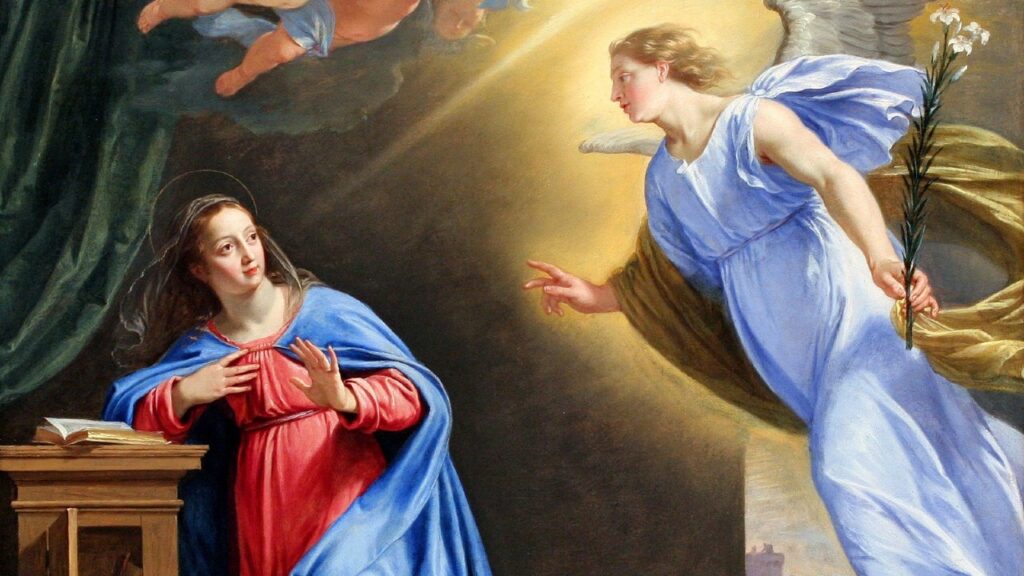
The perpetual virginity of the Mother of God is summarized in this formula: Mary was virgin before giving birth, while giving birth, and after giving birth. These three elements of the dogma affirm the virginal conception of Jesus, because Mary was mother by divine means, without human cooperation; the miraculous birth of Jesus “did not diminish his Mother’s virginal integrity but sanctified it” (Lumen gentium, n.57); and the intactness of Mary after the birth of her Divine Son.
The Old Testament books contained symbols and prophecies regarding the virginity of Mary, as St. Bernard comments: “What did the burning bush that did not consume itself prefigure in its day? Mary giving birth without any pain. And what did the rod of Aaron, which mysteriously flowered, without being planted, symbolize? The Virgin, who conceived without the cooperation of man. Isaiah provides us with the clearest image of the great mystery of this prodigious miracle. ‘And there shall come forth a rod out of the root of Jesse, and a flower shall rise up out of his root,’ thus representing the Virgin by the rod, and her childbirth in the flower.” (ST. BERNARD OF CLAIRVAUX. Laudibus Virginis Matris, II, 5)
The prototypical example is the prophecy of Isaiah, recalled by St. Matthew: “Now all this was done that it might be fulfilled which the Lord spoke by the prophet, saying: ‘Behold a virgin shall be with child, and bring forth a son, and they shall call his name Emmanuel,’ (Is 7:14), which being interpreted is, ‘God with us’” (Mt 1:22-23).
In the New Testament, St. Luke and St. Matthew attest to the virginal conception in affirming that Jesus was begotten by the Holy Spirit: “The Holy Spirit will come upon you, and the power of the most High will overshadow you. And therefore also the child which will be born of you will be called holy, the Son of God” (Lk 1:35); “Joseph, son of David, fear not to take unto thee Mary thy wife, for that which is conceived in her, is of the Holy Spirit” (Mt 1:20)
Despite this scriptural evidence, the virginal maternity of Mary was the target of attacks of various heresies in the first centuries, such as the Ebionite current which denied the divinity of Jesus. Nevertheless, the virginal conception was already considered unquestionable doctrinal patrimony by the Church, (In his Apologia, St. Justin presents the virginal conception of Mary as a fundamental truth of the Christian religion (I,33); and similarly, St. Irenaeus (Adv. Haer. 3,19ss) affirms that this truth is one of those contained in the “rule of Faith” that all should believe) and was placed at the service of the defense of the Redeemer’s divinity. It is at this time, with St. Justin, that the expression “the Virgin” became characteristic in speaking of Mary most holy. (Cf. ALDAMA, José Antonio de. María en la patrística de los siglos I y II. Madrid: BAC, 1970, p.83)
In the fourth century there was a thorough explanation of this dogma in reaction to the errors of the time. Great writers such as St. Epiphanius, St. Jerome, St. Ambrose and St. Augustine, defended the perpetual virginity of Mary. There are beautiful pages dedicated to praising this Marian privilege by the Bishop of Hippo, as glimpsed in the passage: “Mary remained a virgin conceiving, a virgin bearing, a virgin bringing forth, a virgin perpetual. Why do you wonder at this O man?
Once God had deigned to become man, it was fitting that He be born in this way.” ( ST. AUGUSTINE. Sermon 186,1 )
It was not long before the recognition of the Magisterium was added to theological studies. The proclamation of the dogma fell to the Lateran Synod of 649, convoked by Pope St. Martin I.
After the heated Christological controversy of its early days that led to the first Marian dogmatic definitions, the Church would wait twelve centuries for a new official definition on the Mother of God. This time, it was not provoked by the need to combat heresies, but by another powerful factor of dogmatic development: the sensus fidei.
The Immaculate Conception: triumph of Christian piety
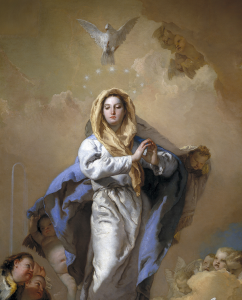
The definition of the dogma of the Immaculate Conception is a paradigmatic example of the ecclesial Faith which, by special assistance of the Holy Spirit, grows and increases in the understanding of revealed truths. In this instance, the Christian people, “who do not know theology, but have the ‘instinct of faith,’ which comes from the same Holy Spirit, and has them perceive the truth, even if they do not know how to demonstrate it,” (ROYO MARÍN, OP, Antonio. La Virgen María: teología y espiritualidad marianas.2.ed. Madrid: BAC, 1997, p.75) anticipated the learned and scholarly in believing in the Immaculate Conception of Mary.
Urged by the instinctive faith of the faithful, theologians sought to furnish plausible arguments for the belief and to harmonize it with the ensemble of Revelation. It was in this regard that the theory of the Immaculate Conception was not grasped even by great and pious doctors, including St. Bernard, St. Anselm, St. Bonaventure, St. Albert the Great and St. Thomas Aquinas, who did not venture to defend the proclamation of this dogma since they could not reconcile it with Catholic Doctrine concerning the transmission of original sin and the universal redemption worked by Christ.
A worthy reaction in favour of the dogma surfaced years later, with Blessed John Duns Scotus, who “after firmly determining the true terms of the question, with admirable clarity established the solid foundations for dispelling the problems posed by those against the singular Marian prerogative.”(CLÁ DIAS, EP, João Scognamiglio. Pequeno ofício da Imaculada Conceição comentado. São Paulo: Artpress, 1997, p.496.) These foundations consisted, above all, in the elaboration of the concept of preventive redemption, the decisive argument for the doctrine on the Immaculate Conception.
Theologians argue that there are two ways of liberating a captive: paying the price of his ransom to free him from captivity (an analogous situation to liberating redemption, in which, by the merits of Christ, we are cleansed from original sin inherited from our first parents); or paying in advance, thereby preventing the person from falling into captivity (preventive redemption). The latter is a true redemption, more authentic and profound than the first, and is that which was applied to the Blessed Virgin, who was saved harmless from any stain of sin, since the moment of her conception.(Cf. ROYO MARÍN, op. cit., p.75.)
The enthusiasm of the good people of God throughout the world—and especially those of Spain—reverberated in the Vatican. Yet, it would be necessary to wait until December 8, 1854, for the dogma to be declared. Then, as Pius IX affirmed, “the opportune time had come for defining the Immaculate Conception of the Blessed Virgin Mary, Mother of God, which Holy Scripture, venerable Tradition, the constant mind of the Church, the desire of Catholic bishops and the faithful, and the memorable Acts and Constitutions of our predecessors, wonderfully illustrate and proclaim.”(PIUS IX. Ineffabilis Deus, n.22.)
The solemn definition took place in the Vatican Basilica before a multitude of ecclesiastical authorities and the faithful. An eyewitness of this memorable occasion noted: “As it was long ago in Ephesus, so it is in Rome today: there are popular celebrations for Mary everywhere. The Romans prepare to receive the definition of the Immaculate Conception, as the Ephesians welcomed the Divine Maternity of Mary: with hymns of rejoicing and demonstrations of truly ardent enthusiasm.”(CHANTREL, Joseph. Histoire populaire des papes, apud CLÁ DIAS, op. cit., p.501)
The Spanish faithful, who played an important role in the spreading of this truth, immortalized their love for the “Immaculate”, with this expression: “Ave María Purísima, sin pecado concebida (Hail Mary most pure, conceived without sin)!”
Mary assumed into Heaven
The proclamation of the dogma of the Assumption, defined by Pius XII almost a century later, is another beautiful example of the maturation of ecclesial Faith.
Popular devotion to the Assumption of Mary body and soul into heaven found its earliest expression in an ancient Eastern liturgical celebration. Prior to this celebration are the first references of Tradition on the final destiny of the Blessed Virgin, appearing between the fourth and fifth centuries. Among these, the assertions of St. Ephraim and St. Epiphanius stand out. In the following century the testimonies of the Fathers became more numerous; of key importance are the homilies of St. Andrew of Crete, and St. John Damascene, “an outstanding herald of this traditional truth.” (PIUS XII. Munificentissimus Deus, n.21)
Following the Fathers of the Church, the scholastic theologians clearly explain the significance of the Assumption and its profound connection with other revealed truths, contributing considerably toward the gradual propagation of this privilege of the Mother of God. From the fifteenth century onward, theologians were generally of one accord in affirming this. To these liturgical, patristic and theological testimonies, it is fitting to add the numerous expressions of popular piety, including the dedication of one of the mysteries of the Rosary to this truth.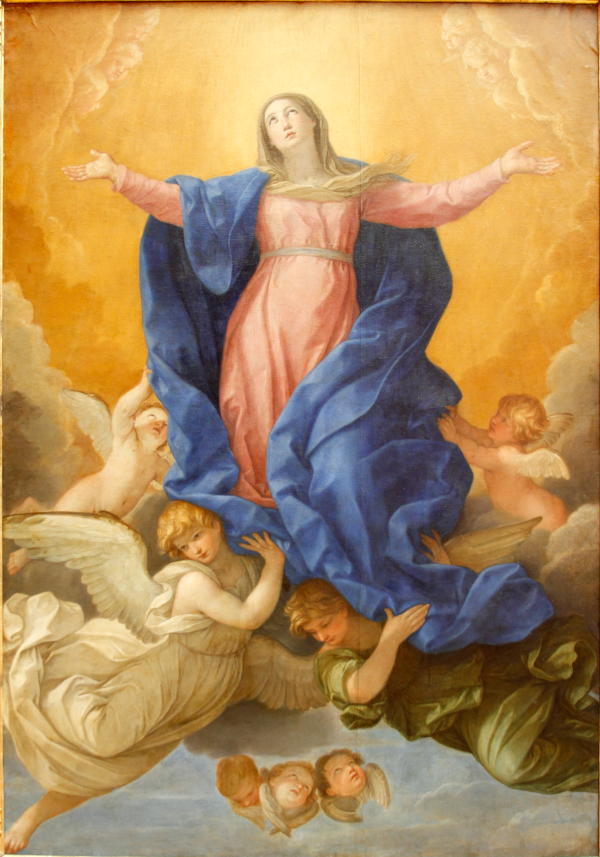
This ecclesial consensus is cited by Pius XII as a fundamental argument for the dogmatic proclamation of the Assumption, since it shows “the concordant teaching of the Church’s ordinary doctrinal authority and the concordant faith of the Christian people which the same doctrinal authority sustains and directs, thus by itself and in an entirely certain and infallible way, manifests this privilege as a truth revealed by God and contained in that divine deposit which Christ has delivered to his Spouse to be guarded faithfully and to be taught infallibly.”(PIUS XII. Munificentissimus Deus, n.12) Based on these presuppositions, the solemn definition was made in 1950.
The mood surrounding the dogmatic declaration of the Assumption was, without doubt, one of pomp, as captured in the photographs of the time. Numerous cardinals, bishops, priests and religious, along with a multitude of faithful, gathered in St. Peter’s Square, while countless others worldwide accompanied the broadcast via radio and television. It was the Catholic orb united as “one heart and one soul” (Acts 4:32), assisting the solemn proclamation of the Faith that they professed in one voice.
The defining words were as follows: “For the glory of Almighty God who has lavished his special affection upon the Virgin Mary, for the honor of her Son, the immortal King of the Ages and the Victor over sin and death, for the increase of the glory of that same august Mother, and for the joy and exultation of the entire Church; by the authority of our Lord Jesus Christ, of the Blessed Apostles Peter and Paul, and by our own authority, we pronounce, declare, and define it to be a divinely revealed dogma: that the Immaculate Mother of God, the ever Virgin Mary, having completed the course of her earthly life, was assumed body and soul into heavenly glory.” (PIUS XII. Munificentissimus Deus, n.44).
Sign of growth and strengthening
In the few episodes in the Gospel that recall Jesus’ infancy, there is an admirable , if succinct, summary of the earliest years of the Word of God made flesh: “And the Child grew and became strong, filled with wisdom; and the favour of God was upon Him” (Lk 2:40). These words referring to Christ can also be applied to His Mystical Body, which continually grows and becomes stronger, vivified by the Holy Spirit that animates it.
In concluding this reflection, it is consoling to note the degree in which dogmatic definitions constitute one of the most beautiful manifestations of this growth. As Father Garrigou-Lagrange teaches, the solemn declaration of the truths of Faith and their increasingly profound penetration in the Christian people, exhibit the principal consequence of leading them to the comprehension—to the degree possible on this earth—of He who “loves us more than we can imagine and desire, even wanting to unite us with His intimate life, leading us little by little to see Him as He sees Himself and to love Him as He loves Himself.”(GARRIGOU-LAGRANGE, OP, Réginald. El sentido común: la filosofía del ser y las fórmulas dogmáticas. Buenos Aires: Desclée de Brouwer, 1945, p.240)
Therefore, if the main goal of the solemn declaration of a truth of the Faith is to lead to the knowledge of God and the realities concerning Him, it stands to reason that the most important theological implication of Marian dogmas must be to provide—starting from the explanation of content from Revelation—a greater knowledge concerning her who God chose for Mother and united to Himself and the entire Church in a very special manner.
Thus the Church understood that, starting with the exegesis of Scripture, the sounding out of Tradition, theological work and fidelity to the action of the Holy Spirit in souls, vast panoramas were opened in the understanding of the Blessed Virgin and her Divine Son.
In the first centuries, the nascent Church saw itself shaken by diverse heresies. Did this pose a great danger? Undoubtedly. But it was also the excellent opportunity for doctrinal consolidation, an effort which perhaps would not have been undertaken if it were not for the apologetical necessity.
Proof of this are the solemn declaration of the divine maternity and perpetual virginity, dogmas that broaden the horizons of Catholic Doctrine, conferring upon Our Lady a unique distinction. The foundations of Mariology were cast, the doors were opened to the blossoming of feasts in honour of the Mother of God and the solid basis established for the Marian devotion of the faithful.
With the passing of centuries and the solidification of doctrinal strength, another form of devotional progress was able to surface, this time stemming from a super natural sense of Faith. The already defined revealed truths, their doctrinal corollaries and their liturgical manifestations, are the basis for the beneficent action of the Holy Spirit, which inspires new insights among the faithful. These were gathered by the Magisterium of the Church and, from these new fruits added to the list of the truths of Faith, are proclaimed the dogmas of the Immaculate Conception and the Assumption of Mary.
A living organism and—contrary to the laws of nature—in a constant state of renewal, the Church may yet yield new Marian dogmas, such as for example, that of the universal mediation and the co-redemption of the Blessed Virgin, if by this it will foster the fulfilment of its mission. Far from being coercive and obsolete strictures, they will reaffirm Mary’s timeless Christocentric counsel: “Do whatever He tells you” (Jn 2:5), inviting us to loving adherence to the Magisterium of the Church, “pillar and bulwark of the truth” (1 Tm 3:15).
